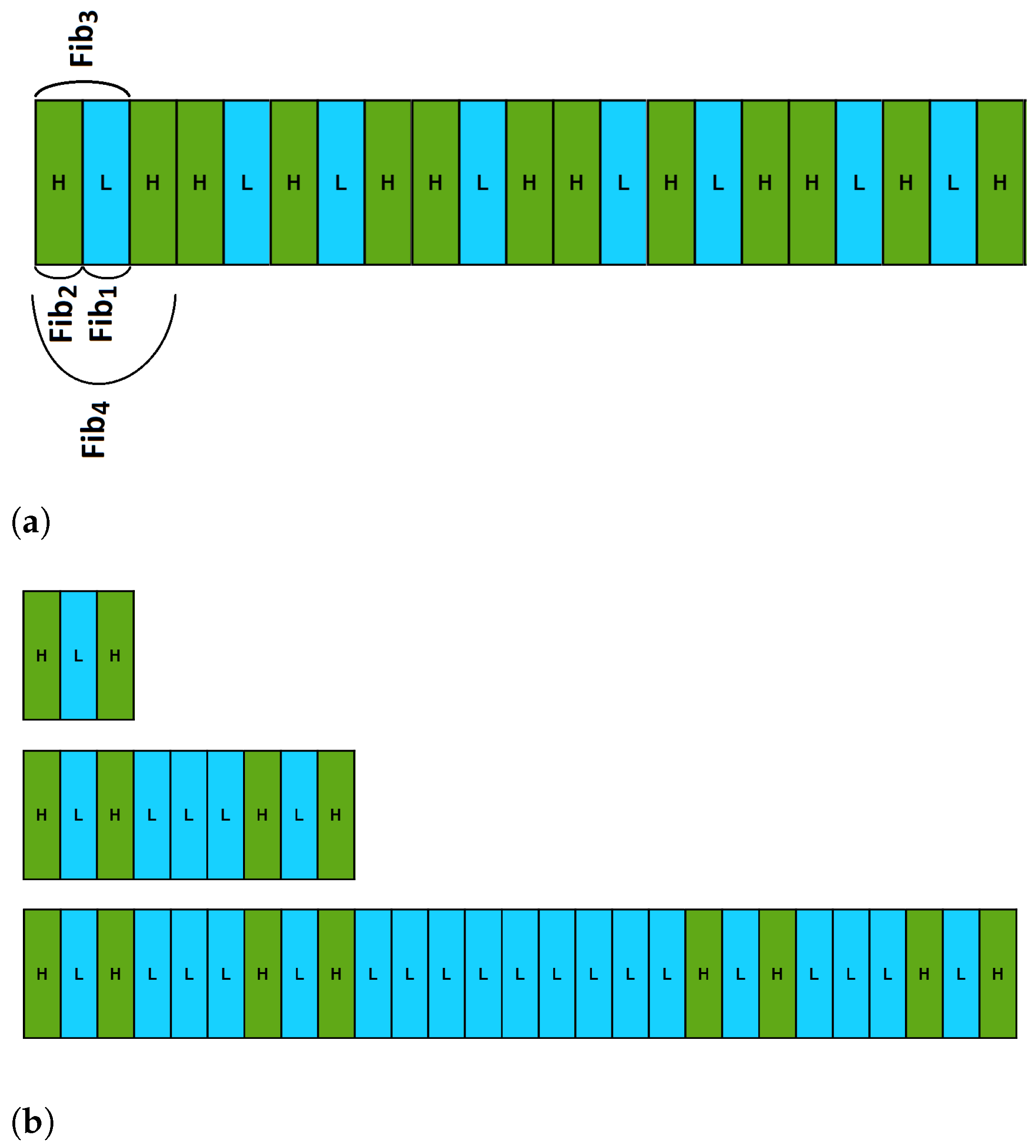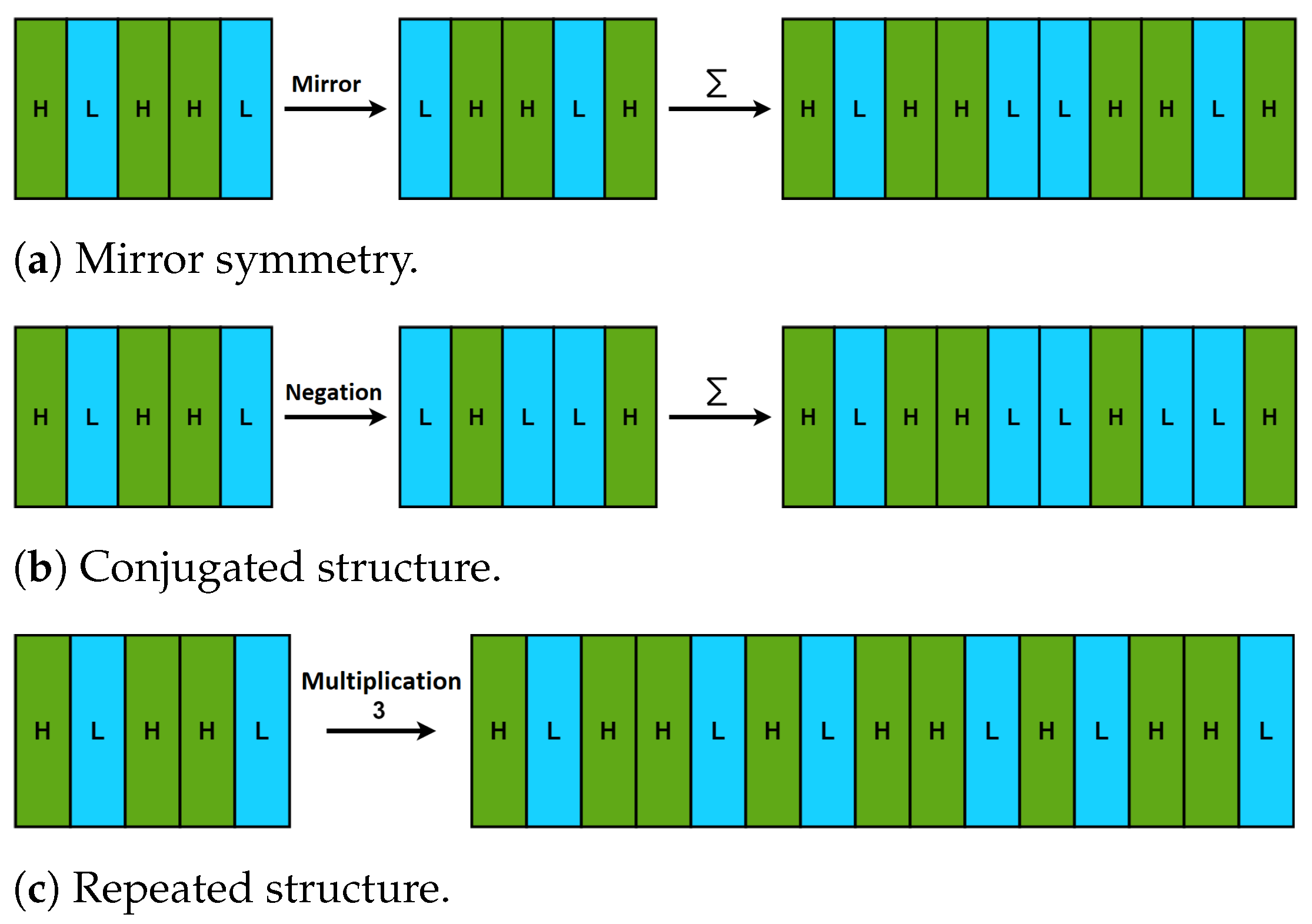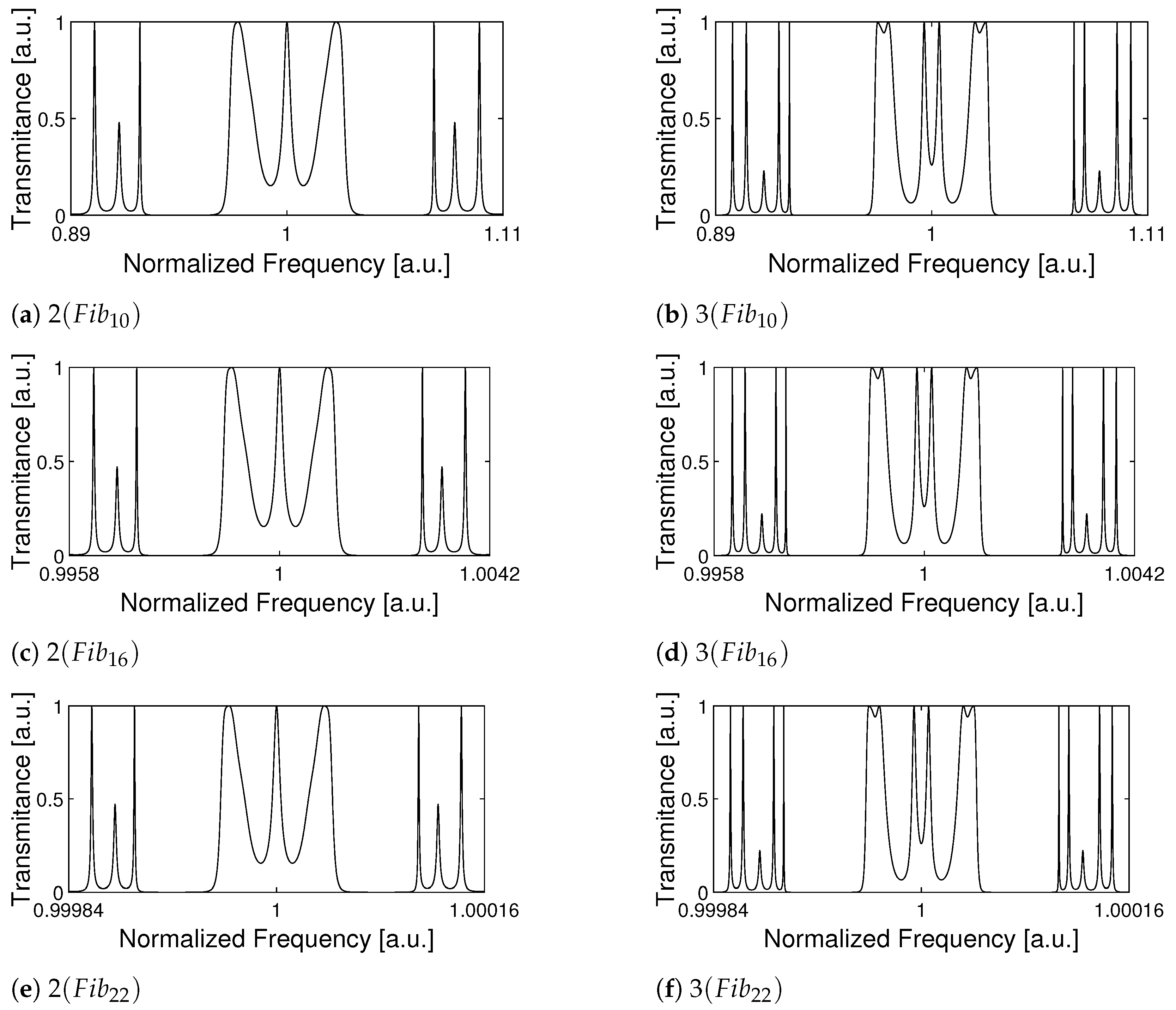Self-Similarity Properties of Complex Quasi-Periodic Fibonacci and Cantor Photonic Crystals
Abstract
:1. Introduction
2. Materials and Methods
- concatenation structure—in which successive elements are created on the basis of the structure of the lower order. In case of the work presented here, the first two elements were defined as , , , … for . Resulting quasi-periodic structure fulfills the Fibonacci sequence, and is further referred to as a Fibonacci structure (, where n is the order of the structure). The example of the Fibonacci structure of the eighth order is presented in Figure 1a.
- fractal structure—in which successive elements are formed in an iterative algorithm, by transforming each layer of the structure in a strictly defined manner. Cantor structure, described in detail in a previous section is an example of the fractal. In case of the work presented here, the 0th order of the structure is defined as a uniform slab of material H with higher refractive index. The algorithm for the creation of the higher orders of the Cantor structure (, where n is the order of the Cantor structure) is very straight forward. To create Cantor structure of the first order (), the length of the H material is divided in three equal sections, and the middle section is then replaced with the L material with lower refractive index. For the creation of the nth order of the Cantor structure, the procedure is repeated recursively for each H section of the Cantor structure from to . Every L section of each resulting order of the Cantor structure always remains unchanged. The example of the first three orders of the Cantor structures created by the above set of rules is presented in Figure 1b.
3. Results
3.1. Modified Fibonacci Structures
3.2. Modified Cantor Structures
4. Discussion
Author Contributions
Funding
Institutional Review Board Statement
Informed Consent Statement
Data Availability Statement
Conflicts of Interest
Abbreviations
| QP | quasi-periodic |
| PhC | photonic crystal |
| EM | electro-magnetic |
| TMM | transfer matrix method |
References
- MacLeod, H.A. Thin-Film Optical Filters; Taylor & Francis Ltd.: London, UK, 2021. [Google Scholar]
- Yablonovitch, E. Inhibited Spontaneous Emission in Solid-State Physics and Electronics. Phys. Rev. Lett. 1987, 58, 2059–2062. [Google Scholar] [CrossRef] [Green Version]
- John, S. Strong localization of photons in certain disordered dielectric superlattices. Phys. Rev. Lett. 1987, 58, 2486–2489. [Google Scholar] [CrossRef] [PubMed] [Green Version]
- Ginzburg, N.S.; Peskov, N.Y.; Sergeev, A.S.; Phelps, A.D.R.; Cross, A.W.; Konoplev, I.V. The use of a hybrid resonator consisting of one-dimensional and two-dimensional Bragg reflectors for generation of spatially coherent radiation in a coaxial free-electron laser. Phys. Plasmas 2002, 9, 2798–2802. [Google Scholar] [CrossRef]
- Strauf, S.; Hennessy, K.; Rakher, M.T.; Choi, Y.S.; Badolato, A.; Andreani, L.C.; Hu, E.L.; Petroff, P.M.; Bouwmeester, D. Self-Tuned Quantum Dot Gain in Photonic Crystal Lasers. Phys. Rev. Lett. 2006, 96, 127404. [Google Scholar] [CrossRef] [PubMed] [Green Version]
- VCSELs; Springer GmbH: Berlin/Heidelberg, Germany, 2012.
- Nishijima, Y.; Ueno, K.; Juodkazis, S.; Mizeikis, V.; Misawa, H.; Tanimura, T.; Maeda, K. Inverse silica opal photonic crystals for optical sensing applications. Opt. Express 2007, 15, 12979. [Google Scholar] [CrossRef] [PubMed]
- Descrovi, E.; Frascella, F.; Sciacca, B.; Geobaldo, F.; Dominici, L.; Michelotti, F. Coupling of surface waves in highly defined one-dimensional porous silicon photonic crystals for gas sensing applications. Appl. Phys. Lett. 2007, 91, 241109. [Google Scholar] [CrossRef] [Green Version]
- Troia, B.; Paolicelli, A.; De, F.; Passaro, V.M.N. Photonic Crystals for Optical Sensing: A Review. In Advances in Photonic Crystals; IntechOpen Ltd.: London, UK, 2013. [Google Scholar] [CrossRef] [Green Version]
- Shen, W.; Li, M.; Ye, C.; Jiang, L.; Song, Y. Direct-writing colloidal photonic crystal microfluidic chips by inkjet printing for label-free protein detection. Lab Chip 2012, 12, 3089. [Google Scholar] [CrossRef] [PubMed]
- Zhang, Y.; Zhao, Y.; Zhou, T.; Wu, Q. Applications and developments of on-chip biochemical sensors based on optofluidic photonic crystal cavities. Lab Chip 2018, 18, 57–74. [Google Scholar] [CrossRef] [PubMed]
- Cubukcu, E.; Aydin, K.; Ozbay, E.; Foteinopoulou, S.; Soukoulis, C.M. Negative refraction by photonic crystals. Nature 2003, 423, 604–605. [Google Scholar] [CrossRef] [PubMed]
- Noori, M.; Soroosh, M.; Baghban, H. Self-Collimation in Photonic Crystals: Applications and Opportunities. Annalen Physik 2017, 530, 1700049. [Google Scholar] [CrossRef] [Green Version]
- Zhang, Y.; Li, B. Photonic crystal-based bending waveguides for optical interconnections. Opt. Express 2006, 14, 5723. [Google Scholar] [CrossRef] [PubMed]
- Martin, P. Handbook of Deposition Technologies for Films and Coatings: Science, Applications and Technology; Elsevier: Amsterdam, The Netherlands, 2010. [Google Scholar]
- Yeh, P.; Yariv, A.; Hong, C.S. Electromagnetic propagation in periodic stratified media. I. General theory. J. Opt. Soc. Am. 1977, 67, 423. [Google Scholar] [CrossRef] [Green Version]
- Yariv, A.; Yeh, P. Electromagnetic propagation in periodic stratified media. II. Birefringence, phase matching, and X-ray lasers. J. Opt. Soc. Am. 1977, 67, 438. [Google Scholar] [CrossRef]
- Kohmoto, M.; Sutherland, B.; Iguchi, K. Localization of optics: Quasiperiodic media. Phys. Rev. Lett. 1987, 58, 2436–2438. [Google Scholar] [CrossRef] [PubMed]
- Gellermann, W.; Kohmoto, M.; Sutherland, B.; Taylor, P.C. Localization of light waves in Fibonacci dielectric multilayers. Phys. Rev. Lett. 1994, 72, 633–636. [Google Scholar] [CrossRef] [PubMed]
- Mauriz, P.; Vasconcelos, M.; Albuquerque, E. Optical transmission spectra in symmetrical Fibonacci photonic multilayers. Phys. Lett. A 2009, 373, 496–500. [Google Scholar] [CrossRef]
- Wu, J.; Gao, J. Transmission properties of Fibonacci quasi-periodic one-dimensional superconducting photonic crystals. Optik 2012, 123, 986–988. [Google Scholar] [CrossRef]
- Trabelsi, Y.; Ali, N.B.; Belhadj, W.; Kanzari, M. Photonic Band Gap Properties of One-dimensional Generalized Fibonacci Photonic Quasicrystal Containing Superconductor Material. J. Supercond. Nov. Magn. 2019, 32, 3541–3547. [Google Scholar] [CrossRef]
- Vasconcelos, M.S.; Albuquerque, E.L.; Mariz, A.M. Optical localization in quasi-periodic multilayers. J. Phys. Condens. Matter 1998, 10, 5839–5849. [Google Scholar] [CrossRef]
- Lavrinenko, A.V.; Zhukovsky, S.V.; Sandomirski, K.S.; Gaponenko, S.V. Propagation of classical waves in nonperiodic media: Scaling properties of an optical Cantor filter. Phys. Rev. E 2002, 65, 036621. [Google Scholar] [CrossRef] [PubMed] [Green Version]
- Zhukovsky, S.V.; Lavrinenko, A.V.; Gaponenko, S.V. Spectral scalability as a result of geometrical self-similarity in fractal multilayers. Europhys. Lett. 2004, 66, 455–461. [Google Scholar] [CrossRef]
- Zhukovsky, S.; Lavrinenko, A. Spectral self-similarity in fractal one-dimensional photonic structures. Photonics Nanostruct. Fundam. Appl. 2005, 3, 129–133. [Google Scholar] [CrossRef]
- Huang, X.; Wang, Y.; Gong, C. Numerical investigation of light-wave localization in optical Fibonacci superlattices with symmetric internal structure. J. Phys. Condens. Matter 1999, 11, 7645–7651. [Google Scholar] [CrossRef]
- Zhukovsky, S.V. Perfect transmission and highly asymmetric light localization in photonic multilayers. Phys. Rev. A 2010, 81, 053808. [Google Scholar] [CrossRef] [Green Version]
- Bouazzi, Y.; Kanzari, M. Optical Fabry–Perot filter based on photonic band gap quasi-periodic one-dimensional multilayer according to the definite Rudin–Shapiro distribution. Opt. Commun. 2012, 285, 2774–2779. [Google Scholar] [CrossRef]
- Jena, S.; Tokas, R.; Sarkar, P.; Misal, J.; Haque, S.M.; Rao, K.; Thakur, S.; Sahoo, N. Omnidirectional photonic band gap in magnetron sputtered TiO2/SiO2 one dimensional photonic crystal. Thin Solid Films 2016, 599, 138–144. [Google Scholar] [CrossRef]








Publisher’s Note: MDPI stays neutral with regard to jurisdictional claims in published maps and institutional affiliations. |
© 2021 by the authors. Licensee MDPI, Basel, Switzerland. This article is an open access article distributed under the terms and conditions of the Creative Commons Attribution (CC BY) license (https://creativecommons.org/licenses/by/4.0/).
Share and Cite
Augustyniak, A.; Zdanowicz, M.; Osuch, T. Self-Similarity Properties of Complex Quasi-Periodic Fibonacci and Cantor Photonic Crystals. Photonics 2021, 8, 558. https://doi.org/10.3390/photonics8120558
Augustyniak A, Zdanowicz M, Osuch T. Self-Similarity Properties of Complex Quasi-Periodic Fibonacci and Cantor Photonic Crystals. Photonics. 2021; 8(12):558. https://doi.org/10.3390/photonics8120558
Chicago/Turabian StyleAugustyniak, Aleksander, Mariusz Zdanowicz, and Tomasz Osuch. 2021. "Self-Similarity Properties of Complex Quasi-Periodic Fibonacci and Cantor Photonic Crystals" Photonics 8, no. 12: 558. https://doi.org/10.3390/photonics8120558
APA StyleAugustyniak, A., Zdanowicz, M., & Osuch, T. (2021). Self-Similarity Properties of Complex Quasi-Periodic Fibonacci and Cantor Photonic Crystals. Photonics, 8(12), 558. https://doi.org/10.3390/photonics8120558





